
The embodiment of man was not prepared
by the uprising of the human body.
The body rose up,
as the form became human.
Louis Bolk
Man and the chimpanzee
Louis Bolk and the chimpanzee
A fetus of a chimpanzee
Early last century Louis Bolk, professor of anatomy in Amsterdam, Holland, received a 7 months- old chimpanzee fetus. Chimpanzees are born after a gestation period of eight months, so the fetus was about a month from delivery. Bolk saw a fetus with remarkably humanlike hair growth. The figure on the right shows that the chimpanzee fetus has hair only on top of its head and around its mouth, the same as with humans. Otherwise the fetus is hairless, as with humans.
Bolk was impressed by the hair of this unborn ape. With humans, the hair on the head offers the upright going human protection against solar radiation and the further hairless skin makes sweating easy. But why should the fetus of a chimpanzee have such humanlike hair, functional for humans, that later turns into the hair growth of an ape, covering the whole body? Bolk was mystified and puzzled.
The face
The human hair was not the only remarkable phenomenon that Bolk saw, there were more striking features. On the drawing of a baby - and an adult chimpanzee beneath, one can see that the baby has a humanlike high forehead and a flat face. In the adult, the high forehead has disappeared, thick eyebrows have appeared. Furthermore, the head is now tilted back, the mouth has come forward and a snout has developed. The face of the baby chimp resembles the face of a human, the adult chimpanzee no longer does. Again, the flat face has significance for man only, viz. for speech.
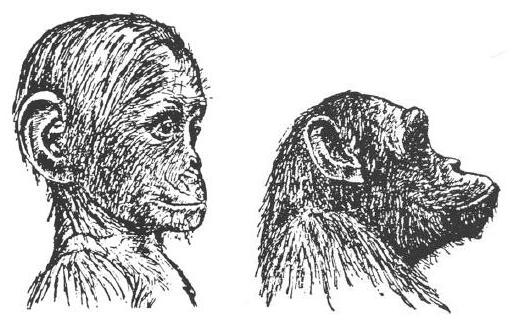
Drawings of a baby - and an adult chimpanzee. The baby shows human characteristics, which the adult chimpanzee has lost, such as the upright head, the high forehead, the flat face and the small, restrained nose.
The position of the head
The same figure also shows that the head of the newborn chimpanzee stands upright on the neck and rump. The foramen magnum (the hole at the base of the skull connected to the backbone) is in the midst of the skull. Therefore the skull is completely in balance and can be held upright without effort. With the maturing of the chimpanzee the foramen shifts back, whereby the skull tilts and the snout emerges. A chimp does not walk upright, the tilt of his head still allows him to look still straight ahead. Again, the baby chimpanzee shows a feature that is lost when it grows up, it is important for man and not for the adult chimpanzee.
The head of a fetal chimpanzee shows characteristics of the head of an adult human. The fetal and young chimpanzee have got those features, but lose them. They have no significance for the adult chimpanzee. The head hair, hairless skin, the location of the foramen and the flat face are important for humans only.
The human form
Jos Verhulst has taken up the work of Louis Bolk and he has developed it further. In his book "Der Erstgeborene"/"Developmental dynamics in humans and other Primates" he shows that the human form can be explained from two characteristics:
- humans retain fetal characteristics and
- humans have a long development time, which gives body parts that emerge late in the embryonic development a long time to grow and develop.
Humans retain fetal characteristics
Fetalization
The head hair, the hairless skin, the flat face, the held-back snout, the upright head, they are features the fetal chimpanzee first develops and then loses while growing up, whereas man keeps them. Louis Bolk spoke of man as a fetal ape, "an ape fetus that has become sexually mature". Man retains fetal characteristics. Bolk called this phenomenon fetalization.
Specialization
Since he sticks to the fetal form, man does not specialize. Apes specialize, they abandon the fetal form and develop ape characteristics. Man says no to any adjustments that apes, monkeys and other animals develop. Someone commented that man in his evolutionary development said: "No! No! A thousand times no!" to specializations.
Besides the ones already mentioned, there are more examples of fetal characteristics retained by man. Some examples:
The jaw
Just as with humans, a young ape has a closed, curved set of teeth. The teeth are straight and the canines are not much bigger than the other teeth. In growing up to an adult, apes lose these characteristics while man retains them. In the closed row of teeth interruptions arise, the curved row of teeth becomes rectangular. Adult primates have large canine teeth, in humans they remain small. And the incisors are not upright, but point forward. The closed curved row of teeth is important for the formation of sounds and speech. Apes first have the human form, but lose it.

Milk teeth and mature teeth of man (top) and the orang-utan (below)
Formation of the snout of the orang-utan lengthens the row of teeth. The curved form becomes rectangular. Man retains the curved row.
Heart and lungs
In the early embryonic development of all mammals the heart lies against the diaphragm. In humans this remains the position of the heart. For a bipedal, upright walking organism this place is sensible, as it gives the heart support. Later on, most mammals develop a lobe of the lungs between the heart and diaphragm. This figures: the heart of quadrupeds does not need the support of the diaphragm. Apes have a much less developed lobe than other mammals. Again, man stays with the original form, which is beneficial for him only - because of his erect posture. For quadrupeds it has no significance.
The long development time of man
Compared to other mammals, man gets old and all of his life-stages are long. Bolk said:
"There is not a mammal that grows as slowly as humans and there is not one whose full development takes so long to complete ... What is the essence of man as an organism? The obvious answer is: The slow progress of his life."
In general, the lifespan of mammals increases with body- and brain weight. That is why carnivores, having larger brains, live longer than ungulates. A lion (120 kg) lives 24 years, a cougar (70 kg) 20 years, a giraffe (750 kg) 28 years and a wildebeest (165 kg) 17 years. Apes (chimpanzees, gorillas, orang-utans and gibbons) are about as heavy as human beings and grow to be only 30 to 40 years old. Still, much older than other mammals. Man grows to be more than 70, a lot older. This is why only man has a post-reproductive period.
Another approach is the number of times a mammal breathes. This proves to be constant and is 190 million times in their lives. Rapid-breathing animals (mice, for example) live shorter than slow-breathing animals (cattle, etc.). Apes and humans are exceptions to this rule. Apes already breathe more, but man breathes about 660 million times in a lifespan of 70 years.
Man does not only get old, he takes a long time for all stages of his life. A horse is born after 12 months and weighs 40 kg, man is born after 9 months and he weighs only 3.5 kg. Growth is also slower. The horse's weight doubles in 60 days, a human baby takes about 160 days. A deer is fully grown after 3 years, a lion after 7 years, a gorilla after 10 and an elephant after 14 years, man after 20 years. The development of man is thus remarkably slow.
Man is able to learn during his whole life, a chimpanzee stops learning anything after only eight years.
In addition, the embryonic development of man is slow and of mammals it is increasingly accelerated. In the beginning, a day in the embryonic life of a mouse is equal to four days in man, in the end it is fourteen days. Bolk called the human development delayed or retarded, that of the animals accelerated or propulsive.
Hypermorphosis
The result of the slow and prolonged embryonic and juvenile growth is, that organs and body parts that occur late, have much time to grow and develop. This phenomenon is called hypermorphosis. Some examples:
- The long legs as compared to the arms (the legs occur later than the arms)
- The long upper arms and even longer upper legs (the upper arms and legs occur later than the forearms and legs)
- The big toe and thumb (occur as the last toe or finger)
- The large size of the brains and the neocortex (the brain part that occurs last)
- The chin
- The low position of the larynx.

Skeletons of man and apes
Man is tall and has long legs and short arms, compared to apes. His hands and feet are smaller than those of apes. Apes do not stand upright, except for the gibbon. Man has his skull upright on the spine, the position of the skull of apes is - also because of the snout - forward. Correspondingly, apes have large protrusions on the upper back- and neck vertebrae for the neck muscles. Man has a shorter pelvis and a flatter chest than apes.
The arms and long legs of man
Like a horse and a giraffe, a human has long legs. With one important difference, however: the horse and the giraffe have long toes. In humans it is the upper legs and arms that are long.
During the embryonic development the head is created before the tail. All developments, including the closure of the neural tube and the formation of the digestive tract, start earlier at the head side than at the tail side. And what starts earlier, finishes earlier. What starts later, finishes later, too. Due to the long development time of man, developments that start late can go on for a long time. This gives the rump and the limbs more time to grow than the head region. At first the head is large, later on the rump grows. At birth, the head is 1/4 of the height, in an adult it is 1/8.
This development direction (head to tail, or: cephalo-caudal) can also be seen at the emergence of the buds of the limbs. The limbs occur relatively late in the embryonic development, at the end of the fourth week. The arms occur one day earlier than the legs. The development of the limbs is reversed, because the ends (fingers, toes) emerge earlier than the parts closer to the body: the upper arms and -legs. Here we see another development direction (disto-proximal), see here for more details.
At birth, the arms and legs of humans are not very long, certainly much shorter than the limbs of apes. After birth, the arms grow a little in length (but more than the arms of apes), the (later formed) legs grow much more. The limbs of apes also grow, and the difference between the arms and legs is there, too, but both grow much less than the limbs of humans. Especially the (later formed) upper legs grow much in length. This is seen in humans and to a lesser extent in chimpanzees. Hands and feet (formed early) of humans stay smaller than those of the apes. The thumbs of man (formed relatively late) grow on for a longer time and longer in length.
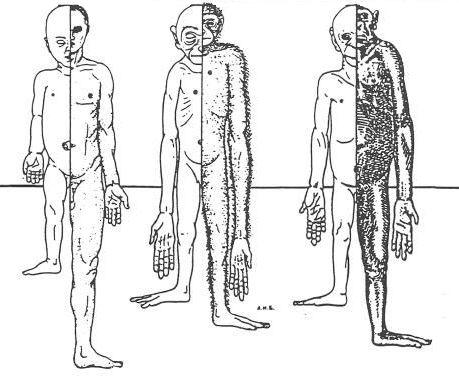
A newly born and an adult human, chimpanzee and gibbon at sitting height.
Man is born with short arms and legs (relative to rump length), the legs grow more in relation to than the arms. The proportions of the two apes alter much less. The arms hardly grow relative to the trunk, the legs do. Compared to the apes man has small hands and feet.
The big brains and the neocortex
The brains are early starters in the embryo, so, why has man got big brains?
Fetal brains grow equally fast in apes and humans, but soon after birth the rapid growth stops in apes and continues in humans. An adult human has 2% brains, a chimpanzee 0.9% and a gorilla only 0.4%.
The explanation is that not all parts of the brains grow and differentiate at the same time. The growth of the brains starts at the spinal cord (the neural tube is formed from the centre) and goes through the cerebellum to the cerebrum. The cerebrum is the last to grow.
In the beginning the cells multiply, and later on they develop into nerve cells that can no longer do that. While in the spinal cord nerve cells are already formed, the undifferentiated cells of the cerebrum are still multiplying. Only from the third embryonic month, the cerebrum is growing and because it can grow for a long time, it grows as big as it gets.
This is repeated in the gray matter, the neocortex, the part of the cerebrum that is the last part of it to grow. Eventually, the gray matter of the brains will occupy 98% of it. This shows that the large cerebrum like the long legs is the result of a late start and long period of growth and no human specialization.
The chin
Only man has a protrusive chin (mental protuberance). On the drawing you can see that man has got a flat face and the chimpanzee not. He has formed a snout by growth of the upper part of the lower jaw, where the denture is implanted, the lower part did not grow as much and slopes back.
The lower jaw of man (and apes) does not grow evenly, there are three distinct zones. The first to grow is the upper part, where the teeth are implanted. In humans this is suppressed. During the change from the milk teeth to the adult teeth this part has reached its final size. The bottom part still grows on. This will form the chin. Finally only the upright rear section still grows, which becomes relatively longer in humans than in chimpanzees. Apes show mostly the first growth movement, the second and third are suppressed. The mandible has the growth movement of the limbs, from the outside inward (disto-proximal). This is not surprising, as the jaw is the limb part of the skull. The protrusive chin is therefore not a specialization, but the result of the long-term growth of man.
The protrusive chin is the place where muscles of the lower lip adhere. They play a role in the formation of sounds and in the expression of antipathy.
The low larynx
The larynx makes speech possible. In babies and animals it has a relatively high position so they can drink and breathe simultaneously. In them the larynx functions as a tube that connects the nose to the windpipe. Adults can not simultaneously breathe and drink through the larynx. In youth the larynx begins to descend. This process begins in the fetus and goes on for a lifetime. At first fast, then slow. Even monkeys have a limited descent of the larynx, apes more than primitive monkeys. The descent enables man to breathe through his nose and through his mouth. He can close his nose and continue breathing. The construction of the larynx is simple, unspecialized.
Speech
Speech is a purely human capacity. Much is needed to be able to speak. Some features have already been mentioned: the flat face and closed curved row of teeth (for tone-shaping), the large brains (speaking is a complex process), the long childhood (to learn the language) and the position of the larynx. But what about the long legs, the position of the foramen and the hairless skin?
Since man walks upright on two legs, his arms are no longer necessary to move forward and he is free to pick things up and carry them. He does not have to do that with his mouth, as animals do. This makes the mouth free to speak. The place of the foramen magnum makes the upright posture possible. Bipedalism has another advantage: breathing is no longer linked to locomotion. In gallop animals breathe in and out with each step, man can do as he likes. Also, man's mouth is not needed to lose warmth, because he has little hair and sweat glands to lose warmth. So, there are many characteristics of fetalization and hypermorphosis that make speech possible.
Verhulst called this co-operation of many seemingly unrelated phenomena the composition phenomenon:
"The composition phenomenon imperatively points to the intentional effect of Bolk's "inner development factor" that works in animal evolution. The target of the progressive retardation in the evolution of the apes becomes only visible at the end, when man appears. Human speech emerges as the centre around which the whole spectrum of the effects of retardation can be grouped as a systematic whole. The appearance of speech on the physical level was the goal that evolution was aiming at. Through man, the word appeared directly in the physical world for the first time."
Based on:
- Jos Verhulst, Developmental dynamics in humans and other Primates, 2005, Floris Books, Edinburgh. Drawings are taken from this book, other images from the internet.
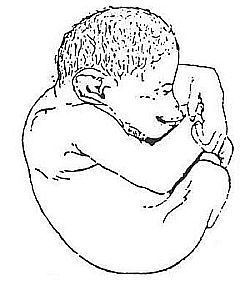
A 7 month old fetus of a chimpanzee. The body is hairless, except for the head. There is hair on the top and a beard and whiskers around the mouth.
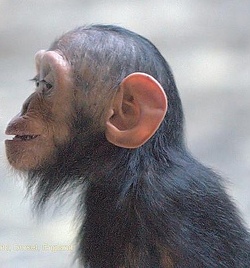
Young chimpanzee

Adult chimpanzee

Adult chimpanzee walking

The skull of an adult chimpanzee. The ridge is for the attachment of the chewing-muscles.
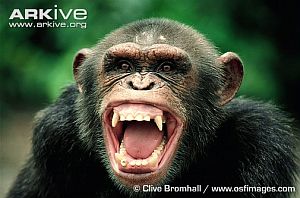
Chimpanzee, note the large canines

Development of the teeth of a chimpanzee
Top: milk teeth, below: adult teeth, an intermediate stage in the middle. First the lower jaw is straight, the canines are small and the incisors stand upright. Slowly the jaw becomes wedge-shaped, the canines grow out and the incisors start standing forward.

Age and life phases of some apes (from primitive monkeys to apes), and humans. Man becomes old and has a extremely long gestation period, youth- and learning time. He is the only one with a long post-reproductive life.

A front leg of a giraffe and an arm of a human
The giraffe has extra long feet and the number of toes is reduced. Humans have an extra long upper arm and no reduction of the number of fingers. The first is a consequence of specialization, the last of hypermorphosis.

Body proportions before birth
Left: fetus 2 months, middle: 5 months, right: newborn baby. The head grows first. After that, its size diminishes relatively, and the trunk and especially the extremities grow out.

Body proportions after birth
From left to right: newborn, 2, 6, 12 and 25 years old. The head decreases in relative size, the body remains the same and the legs grow.
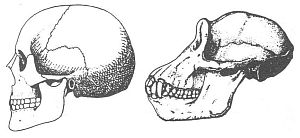
The skull of man and the chimpanzee
The mandible of the chimpanzee is more massive. Its chin slopes back, where that of man is protrusive.

The larynx and the throat

A dog panting with its tongue out of its mouth
tries to lose heat.
